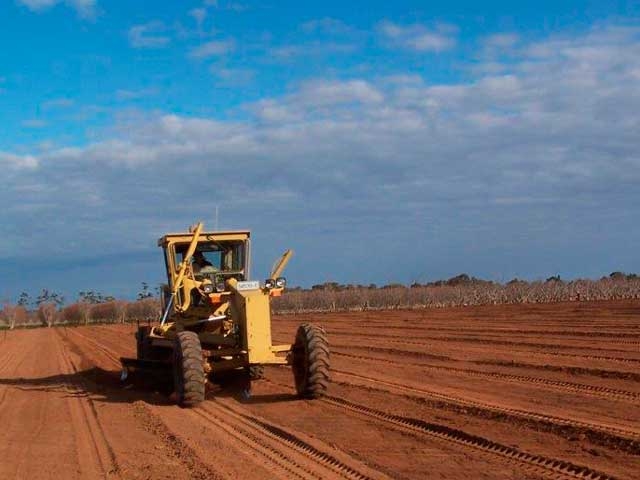Climate and soils of the Goulburn Valley (continued from last month)
Climate and soils of the Goulburn Valley
Subsoils
The subsoils have low saturated hydraulic conductivities, low air-filled porosities when the soil is wet.
In a clay subsoil swelling and clay dispersion can result in low permeability, poor aeration; and when the soil is wet, high soil strength, leading to restricted root development.
Shallow rooting
Tree roots grow mainly in the surface soil, but even there they are usually sparse. Because these soil properties are so often adverse and difficult to control, soil management can affect the performance of the fruit trees.
Experience in the GV has shown that depth of penetration of irrigation water, volume of available water, drainage, impedance and hard soil that restrict roots are the most important soil physical factors that affect tree growth.
In these shallow soils the striking feature is that almost all the roots of the highest concentration of densely-planted fruit trees is found in the surface soil. This high concentration of fine roots near the surface is the most important feature of the root distribution of fruit trees in GV orchards.
This is in marked contrast to the root distribution found in deep soils, where the highest concentrations of roots are not necessarily at the surface.
Shallow rooting of fruit trees on GV soils is caused by a natural barrier. There is little doubt that the hard, heavy subsoil is responsible for the shallow rooting.
Tatura System of Soil Management
Some 40 years ago the Tatura System of Soil Management was developed at the Tatura Research Institute.
The permeability of the hard subsoil and the depth and structure of the surface soil were improved before fruit trees were planted.
The aim of modifying the previously hard impermeable subsoil was to make it more attractive to roots because drainage and aeration were improved.
It has been shown that the greater the friability and the more strongly developed the structure of the subsoil, the bigger the trees grew, as measured by trunk size (circumference) and tree height.
Furthermore, it was found that the greater the trunk size, the deeper is the penetration of roots into the subsoil depths, and the higher is the root concentration in the subsoil.
Subsequent experience has shown that most shallow fragile soils in the GV are capable of successfully growing a wide range of fruit crops.
However, it was not realised at the time that an increased root growth led to a substantial increase in tree vigour and did not allow roots to be controlled as needed in high-density plantings.
Proposed changes to Tatura System
We now propose changing parts of the Tatura System of Soil Management, which would use a sufficiently vigorous rootstock, or sufficiently high tree density, to fill the allotted tree spaces during the mandatory phase of vegetative growth as quickly as possible, and then slow down vegetative growth and initiate full cropping.
Ideally, full cropping fruit trees should be managed so that only minimum concentrations of photosynthates are used for growth and maintenance of shoots and roots, with most directed towards fruit production.
As we gain a better understanding of root physiology in the field, it should be feasible to manage fruit tree roots more directly as we routinely manage tree canopies.
Our proposal for a permanent soil management system is based on firstly allowing close-planted fruit trees, with or without a size-controlling rootstock, to fill their allotted spaces both in the soil and above-ground, within less than three years.
The strategy to achieve this starts with the preparation of the soil before planting the fruit trees.
Preparing the soil before planting
Establishing a high-density orchard is costly. It is important to do it the right way, because you get only one chance.
Once the orchard is established, it is difficult and costly to correct soil problems in later years.
To produce early and high yields of good quality fruit, fruit trees need lots of feeder roots in the surface soil so they can take up plenty of water and nutrients.
To enable this, the surface soil should be deep, soft, stable, well-structured, well-drained, fertile, and cool in summer. Here are steps to achieve that.
The following steps will help you to plan any new planting of fruit trees.
1. Have your soils tested.
Whether it is new or old orchard land, have the surface soil tested to see if you need to add lime, gypsum, and/or phosphorus, and to what depths.
Methods for collecting, preparing and submitting soil samples vary in different regions, states and countries. These methods are described on various websites, so follow the methods appropriate for you.
As you sample the soil, you will also see how deep the surface soil is, and whether there are any hard layers that restrict water, air and roots from deeper layers.
Lime will be needed if the soil pH is acidic (5.7 or less). Gypsum will be needed if the soil is hard due to dispersion. Phosphorus will be needed unless superphosphate has previously been applied each year to the soil and a soil test shows that there is an adequate amount of soluble phosphorus available to the young fruit trees.
2. Rip the surface soil lightly to break up any hard parts and grade your block (if necessary).
Before applying lime, gypsum and/or phosphorus (if soil test results indicate these are needed), laser-grade the block to make sure that it has a slope of at least 1 : 80 along the traffic lanes so that excess water will drain from the surface of the soil.
This will help avoid waterlogging of the surface soil.
The aim is to keep the subsoil not only drainable but also impermeable to discourage roots growing into this layer.
3. Apply lime, gypsum and phosphorus (if necessary), and rip and lightly till the soil (continued next month)
See this article in Tree Fruit Nov 2017






















